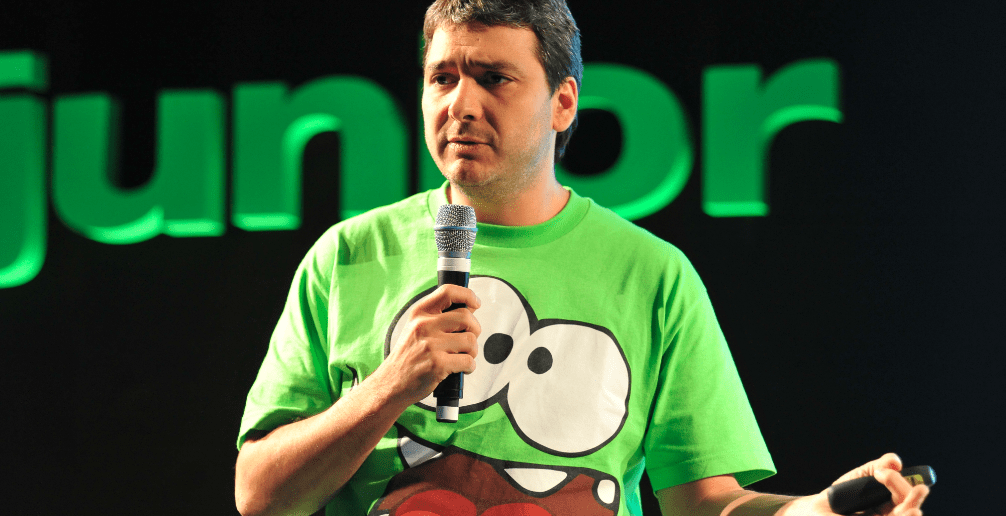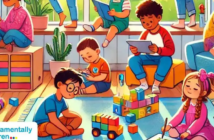Watch full MIPJunior sessions on mipcom.com now! (email req.)
The second day of MIPJunior 2012 has a heavy emphasis on all things digital: apps, websites, virtual worlds and social media. The aim being to examine how children are using different devices to get their entertainment, while also considering case studies of successful multi-platform brands.
The day began with some stats: exclusive research on the way children « connect with each other and with content ». It came from Dr Barbie Clarke, managing director of Family Kids and Youth in the UK, introduced by the morning session’s moderator, Marc Goodchild of IpDipSkyBlue.tv and Agora Media Group.
« I really think it’s important if you’re thinking of producing anything for children… you really really really understand children. And what I mean by that is you understand the difference between ages, » said Clarke.
She was presenting research conducted in July in the UK, including interviews with 933 children aged 7-16, 1,120 parents of 3-16 year-olds, and 202 teachers. Clarke started by looking at the role of friendship and sharing in childhood, and the three stages of development: « Dealing with things » (0-3), « Dealing with people » (3+) and « Dealing with themselves » (7+).
So that first three years is about getting to know their world, but « it’s very, very ecocentric… they don’t actually play with each other. They may sit beside each other, but they’ll be snatching toys… ».
But at three, children start noticing other kids, and start to understand and want friendship, and then at seven-ish it changes again. « They become really quite altruistic, and begin to understand how others function. They become very keen on wanting to save the planet or save the whales… »
« And all of this, of course, is done through play, » added Clarke. « That wish to play stays with us always. It happens in every country, wherever you go in the world. You see people playing in exactly the same way… That need to socialise and that need to play is really key. »
This translates to digital, where Clarke said children are playing in the same way as in the real world. She praised virtual worlds like Moshi Monsters and Club Penguin, but also noted that 70% of children covered by her survey were using social networking sites – including 16% of 3-6 year-olds.
Facebook specifically: 68% of children aged 10-13 are using it, and 28% of 7-10 year-olds, even though you’re supposed to be 13 to sign up. « They’re going there because they have nowhere else to go, » said Clarke, suggesting that Facebook is currently filling a gap in the market for kids who’ve grown out of the virtual worlds.
Device trends: a third of children are online every day by the age of seven, while 58% of children aged 7-16 are using a smartphone, tablet or iPod touch. Of these, 78% download apps.
« What I’m trying to say is just how important connecting and making friends is to children, and that completely relates to their digital world. That’s the key thing to remember, » said Clarke. But she noted that digital play isn’t replacing physical play for children. « They are still playing in cardboard boxes and climbing trees, » she said.
« There’s a lot of negative publicity about the downside of digital technology, perhaps because it’s from a generation that did not grow up with it… I argue it can be used in a very positive way for communication and friendship. »
Case study: Superbia / Where’s My Water? / Club Penguin
Onto the case studies, starting with Disney’s Club Penguin virtual world and Paul Brown, general manager of Disney Interactive and Disney Music Group EMEA. He noted that great characters and powerful storytelling « are media-agnostic », flowing across devices and platforms.
« Our audience is everything, » he said. « Digital enables more direct feedback from our audience… The audience needs to emotionally engage, and that hasn’t changed. It’s about emotional engagement with the characters and the experiences. » But what has changed is the ability for children to connect « any time, anywhere – on their terms ».
He talked about a new service called Superbia, which launched earlier in 2012 using brands from Disney’s TV network. Aimed at 8-14 year-olds, predominantly girls, it lets people register, create avatars, decorate their own virtual rooms, and visit the rooms of their favourite shows’ characters.
Superbia has 2.5m registered users across its launch countries after its first six months, with Disney planning to roll out more content for it. The game’s cheat codes have been redeemed 1.9m times, too, and are being swapped vigorously among children.
Brown also talked about Disney’s mobile game, Where’s My Water?, which stars a brand new character – an alligator called Swampy. In September 2012, it passed 100m total downloads across iOS and Android. It’s got 40m monthly active users, according to Brown.
« What Swampy has in common with Hannah [Montana] and Mickey and Jack Sparrow and Tinker Bell and Winnie the Pooh… he’s a defined character, he has a heart, and it’s a great story, » said Brown. And now Swampy is getting his own animated shorts series online and on Disney’s TV channels, as well as merchandise, board games via a deal with Hasbro, and a presence in Disney’s amusement parks.
Finally, Club Penguin, the virtual world that Disney acquired in 2007, which sees children customising their animated penguins and virtual igloos. This, too, has gone multi-platform, with magazines, console games, toys and a parks presence.
« It’s not just about digital. It’s about digital can be a great driver for other experiences for kids and families, and then how they can go back in. That loop is really key, » said Brown. « Personalisation, character and narrative at the core, and connected – thinking cross platform – and it’s not just about digital. It’s about bringing the digital and physical together. »
What about revenues from all this? « It’s a bit of everything, » said Brown. « There’s absolutely revenue coming through from some of the products and experiences, but they can also be an amazing marketing tool for the company itself… a great driver for other revenue streams. »
Disney also works with external companies, for example mobile developer Imangi Studio, which created a new version of its Temple Run game based on Disney’s Brave film.
Case study: Kinect Sesame Street TV
Next up was Josh Atkins, executive producer from Microsoft UK, and Todd Slepian, senior producer at Sesame Workshop, showing off a new interactive version of Sesame Street designed for the Xbox 360 console and its Kinect controller, which can detect motion and sound in the living room.
They’ve dubbed the idea « two-way TV… trying to reinvent a new television experience ». It’s been tested with more than 200 kids, and is hosted by a new character called Cooper who gets children to jump, teaches them letters, and then introduces interactive videos starring other famous Sesame Street characters.
Atkins showed one with the Cookie Monster, where children are asked to jump to help him shake a tree to find a snack – while finding lots of inedible objects starting with the letter of the day.
« It is a TV show, it’s not a game, » said Atkins, noting that children can choose to interact, or just sit back and watch – in the example shown, if they don’t want to jump, another character turns up to jump with Cookie Monster. The show can be as passive or interactive as children want, without ever forcing them to do anything.
Slepian noted that Sesame Street has been exploring interactivity since 1980, through various devices and technologies. « It wasn’t until recently with this new technology that we were able to create interactive television and break down that fourth wall. »
Lessons learned: It’s important for technology companies to partner with TV companies – « both are powerful on their own, but definitely more powerful together » said Atkins, who also encouraged MIPJunior attendees to believe that their linear shows can be made interactive, even if it’s challenging.
« As the devices that deliver television get more powerful, the expectations from the audience [for interactivity]are going to go up, » he added. Kinect Sesame Street TV launched in September, with parents paying per episode, or buying a season pass.
« We’re just scratching the surface of what we can do today, and it’s a brave new world for television creators to think of a non-linear version… or even a subtly interactive version of what they’re creating, » said Atkins.
Case study: Cut the Rope
The third case study was mobile game Cut the Rope from developer ZeptoLab, which is becoming a cross-platform brand in its own right. CEO Misha Lyalin (photo) talked about the company’s success so far, and its strategy going forward.
Cut the Rope was released two years ago for iPhone, with sequel Cut the Rope Experiments following in August 2011. The company has generated 250m downloads of the two games so far, with 50m active monthly players.
Lyalin noted that the audience is wide for Cut the Rope: not just children, but their parents and other adults. It’s expanded beyond iPhone too: iPad, Android and a free browser-based version.
« Even if people don’t have a smartphone or an iPad or an Android tablet, they can still get access to the game through a browser, » he said. The result: people are « falling in love » with the game’s main character Om Nom, a cute monster. And that’s leading to a range of merchandise: a board game from Mattel, plush toys, and so on.
« Everything we do, we try to make it interactive. We try to make some sort of connection to the game. Even our new line of plush toys has a label where you will be able to point your iPhone or iPad at the label and there will be some form of augmented reality, » said Lyalin.
ZeptoLab is also launching comics to provide the story behind Om Nom. « Children’s content needs a backstory, » said Lyalin. And TV? The company has a deal with Sony Pictures Television to make a live game-show based on Cut the Rope, which was announced last week.
ZeptoLab is also making 50 animated shorts based on Om Nom, with the primary means of distribution likely to be mobile phones, rather than traditional TV. The game itself will become the distribution platform for the animated content, in other words.
All of this is possible because ZeptoLab controlled the rights to Cut the Rope, even though the original game had a publisher, Chillingo.
« IP is the most important thing. Keeping control of IP and being in charge of our own destiny is very important, » said Lyalin. « We have direct access to an incredible amount of consumers… I think now it would be foolish to give up on your content ownership. »
Case study: Small Potatoes
The final case study came from Josh Selig of Little Airplane Productions, whose Small Potatoes started life as a pre-school TV series, but has since expanded onto other platforms with great success.
« We decided to try something that was small and allow it to grow very organically, » he said. « The best brands always start with somebody who really loves that particular character or idea, and that love is conveyed into the pitch materials, into the animation, the marketing and into the whole future of that brand. »
The original show was commissioned by CBeebies in the UK, with the option of going longform or shortform. Selig decided to stay short: « With a commission and a few presales, I can hang onto the IP, I don’t need someone to invest $7m in the first season of the show… I can raise the money myself, and then own the IP and play with the IP. »
Little Airplane then created a Facebook page for the show. One day, one of those fans asked if they could be turned into a potato, which sparked some experimentation. « We put it on the page and the page exploded! We got hundreds and hundreds of requests, » said Selig.
Currently, the company gets 40-50 such requests between 7am and 9am every day, and its designers then turn those people into potatoes. But an interesting thing happened: the fanbase started to skew slightly older, to teenage girls.
« We realised this is not just a pre-school brand actually. This has other appeal, » said Selig, taking inspiration from brands like Hello Kitty and The Muppets. And the popularity has mushroomed: Small Potatoes has nearly 1.2m Likes, ahead of big children’s brands like Sesame Street (650k).
And now? A film. A feature-length animated musical mockumentary about the Small Potatoes characters. Disney picked up the rights, with the premiere set for its Disney Channel and Disney Junior in early 2013. With the twist that people can upload their photos to be turned into potato characters that will appear in the film.
« If you hold onto your IP, you can riff with your IP. You can play, you can experiment. This is the best time in history for experimenting with IP, » said Selig, suggesting that the traditional commissioning model in children’s TV may be broken, given its reliance on commissioning slabs of longform shows in seasons.





2 commentaires
Pingback: Cut the Rope: 250m downloads and 50m active players
Pingback: Mobile app news roundup: Angry Birds, Cut the Rope and how many mobile gamers are willing to pay | Mobile App Dojo